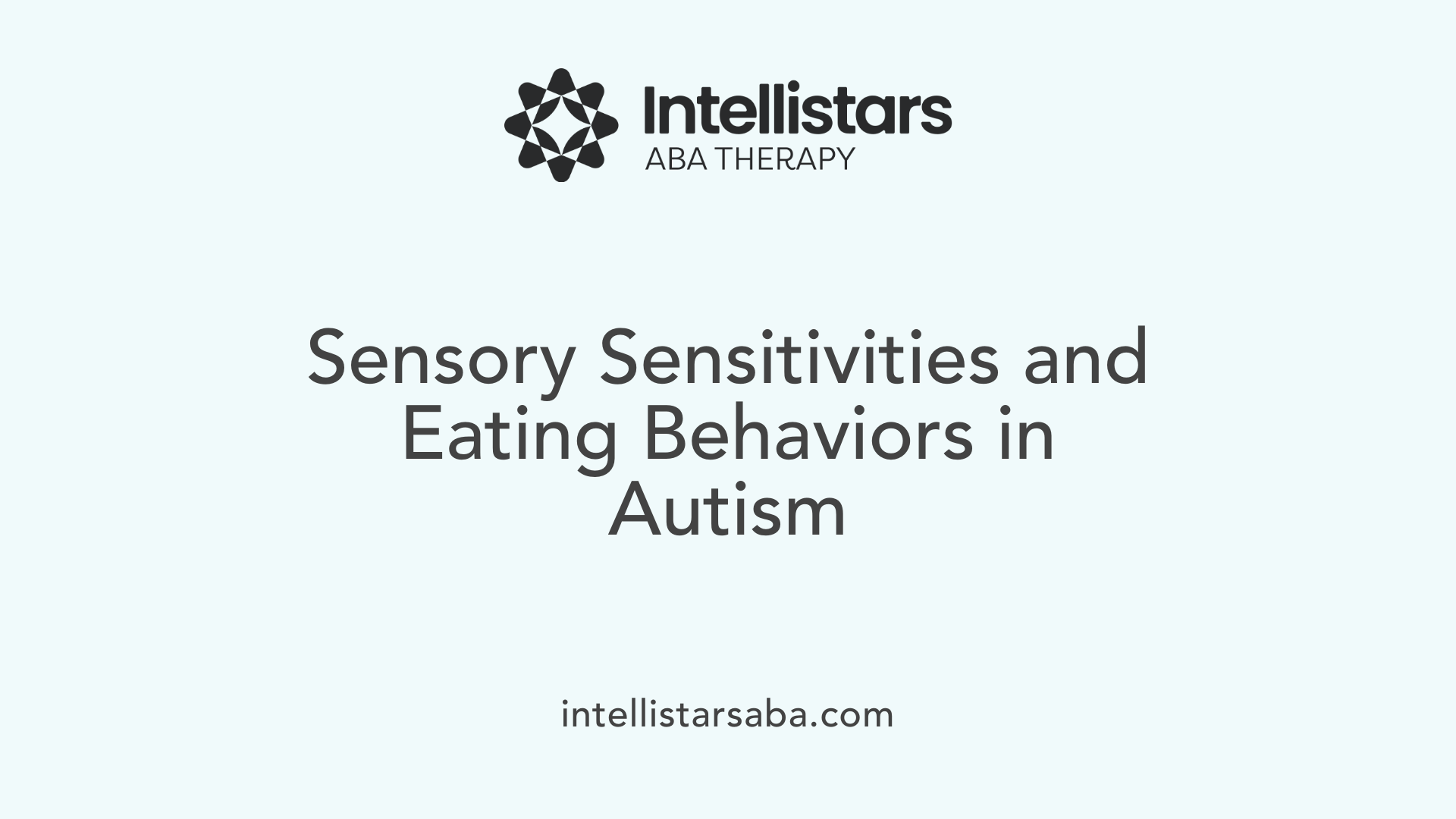Autism and Picky Eating: An Overview
Children with autism spectrum disorder (ASD) often face unique challenges related to eating, characterized by limited food choices, sensory sensitivities, and mealtime behaviors. These issues can significantly impact their nutrition, health, and quality of life, necessitating a nuanced understanding of their underlying causes and effective management strategies.
The Relationship Between Autism and Picky Eating

Is picky eating a symptom of autism?
Picky eating is a common trait among typically developing children, but it often appears more intense and persistent in children with autism spectrum disorder (ASD). Many autistic children develop limited food preferences, sometimes refusing entire food groups or only eating a narrow range of foods. This behavior is frequently linked to sensory processing issues, such as sensitivities to food textures, smells, colors, or temperatures.
Studies indicate that these sensory sensitivities can lead to food selectivity, where autistic children may be wary of trying new foods or accepting foods that differ in texture or appearance from their preferred items. Tools like the Autism Spectrum Disorder-Mealtime Behavior Questionnaire (ASD-MBQ) have shown that mealtime behaviors are closely tied to sensory and social challenges faced by these children.
While picky eating is not a formal symptom of autism, it often reflects broader sensory and behavioral characteristics associated with ASD. Therefore, it should be viewed as part of the overall autism profile rather than a diagnostic criterion. Addressing this behavior requires understanding the underlying sensory sensitivities and behavioral patterns, and implementing tailored interventions to support nutritional health and improve mealtime experiences.
Do children with autism struggle to eat?
Many autistic children face challenges related to eating, including food refusal, selectivity, and sensory sensitivities. These difficulties are common and can be influenced by aversions to textures, tastes, smells, and visual presentation. For example, a child might reject certain foods because they feel too slimy, crunchy, or aromatic.
Mealtime routines often serve as sources of comfort for children with ASD, providing predictability amid sensory overload or anxiety. Some may develop ritualistic behaviors, such as insisting on specific food arrangements or refusal to eat unless certain conditions are met.
Research suggests that these eating issues can sometimes lead to nutritional concerns, especially if the child's diet is severely restricted. Interventions emphasizing gradual exposure, positive reinforcement, and sensory accommodations can help improve eating habits. It’s important to work with healthcare providers to identify whether medical issues, such as gastrointestinal discomfort or oral motor difficulties, are contributing to eating problems.
Why does my autistic child only eat certain foods?
Autistic children often exhibit very selective eating behaviors primarily due to sensory sensitivities. Textures, flavors, colors, and smells can all become triggers for food rejection. For example, a child might refuse foods with a strong aroma or dislike foods that are slimy or gritty.
These sensory sensitivities can result in a limited diet, sometimes only consisting of processed or highly familiar foods that meet their sensory comfort zone. The preference for predictable foods provides a sense of control and safety amid sensory challenges.
This selectivity can lead to nutritional deficits, such as low intake of fruits, vegetables, dairy, and proteins. Strategies to help include pairing new foods with preferred ones, using food chaining (gradually introducing similar textures or flavors), and incorporating play into eating routines. Understanding sensory sensitivities is the first step to developing effective approaches to expand dietary variety.
What are effective strategies for managing picky eating behaviors in children with autism?
Managing picky eating in children with ASD involves patience, consistency, and sensory-aware approaches. Some effective strategies include:
- Gradual introduction of new foods, starting with small portions and pairing them with familiar items.
- Creating a structured mealtime routine that minimizes distractions and reduces anxiety.
- Using visual supports or social stories to prepare children for new foods and mealtime expectations.
- Offering choices to empower children, such as selecting between two healthy options.
- Modifying textures by chopping, blending, or pureeing foods to make them more acceptable.
- Incorporating play into eating, such as exploring food textures or colors in a non-pressurized environment.
- Collaborating with professionals like occupational therapists or dietitians for tailored plans.
Behavioral reinforcement, like praise or small rewards, should be used carefully to encourage acceptance without creating dependency or unwarranted expectations. The key is patience and persistence, recognizing that progress may be slow but achievable.
What are the potential nutritional and health impacts of picky eating on autistic individuals?
Restricted diets in autistic children pose risks for nutritional deficiencies, impacting growth, immune health, and overall well-being. Common deficiencies include vitamin D, B12, iron, calcium, and zinc.
Limited food repertoires often stem from sensory issues or oral motor delays, which may cause gastrointestinal problems like constipation, diarrhea, or reflux. These issues can exacerbate food aversions, creating a cycle of restricted intake and health concerns.
Nutritional gaps can lead to growth concerns, slowed development, and susceptibility to infections. Furthermore, prolonged selective eating can cause stress for families and limit social interactions during meals.
Addressing these impacts involves a multidisciplinary approach, focusing on expanding food variety through sensory-friendly strategies, nutritional supplementation when necessary, and medical management of gastrointestinal and oral health issues.
What medical considerations are relevant for feeding problems in children with autism?
Medical assessment is crucial when feeding problems are present. Detailed evaluations should aim to rule out conditions such as gastrointestinal disorders, oral-motor difficulties, or allergies.
Common issues include acid reflux, constipation, eosinophilic esophagitis, food allergies, and sensory processing disorders.
Dietitians and physicians should assess growth, nutritional status, and potential medical contributors to eating difficulties. Managing underlying medical causes is vital to improving feeding behaviors.
Coordination with speech-language pathologists and occupational therapists enables targeted therapies to address oral-motor and sensory challenges.
How can parents and caregivers support children with autism who have selective eating behaviors?
Parents can play a pivotal role by establishing consistent routines around mealtime. Creating a calm, predictable environment minimizes sensory overload.
Gradual exposure to new foods—starting with small quantities and pairing them with preferred foods—is effective. Offering choices gives children a sense of control, reducing resistance.
Positive reinforcement, such as praise or special activities linked to trying new foods, encourages acceptance.
Involving children in meal planning, shopping, or simple preparation tasks fosters interest and familiarity. Visual aids, social stories, and videos can prepare children for changes.
Professional support from dietitians, occupational therapists, or behavioral analysts can help tailor strategies and address sensory or motor issues. Patience and persistence are essential, as progress can be slow but rewarding.
Addressing picky eating early minimizes nutritional deficits and enhances mealtime enjoyment, contributing to better health and development.
The Impact of Sensory Sensitivities on Eating Behaviors in Autism

Why does my autistic child only eat certain foods?
Children with autism often have very selective eating habits, primarily due to sensory sensitivities and preferences. These sensitivities involve aversions to specific textures, colors, smells, or temperatures, which can make certain foods overwhelming or unappealing. For instance, a child might refuse mushy foods because of tactile sensitivities, or avoid foods with strong odors, leading them to stick to a limited range of familiar, high-carbohydrate options like chips or pasta. This behavior is also influenced by atypical eating patterns, including food avoidance and rigidity around mealtime routines, which can increase the risk of nutritional deficiencies such as inadequate protein or calcium intake.
To help broaden their diets, strategies like pairing new foods with preferred options, incorporating play during mealtime, and gradually introducing variety through methods like food chaining are effective. Understanding these sensory-driven behaviors and addressing sensitivities with patience and creative techniques can promote better nutritional habits.
How do sensory sensitivities influence food selection?
Sensory sensitivities significantly shape food choices in children with autism. Many exhibit over- or under-responsivity to sensory input from foods, such as textures, smells, colors, or temperatures. For example, a child may reject mushy or slimy textures because they feel overwhelming, or avoid foods with strong odors that are intolerable to their sensory system.
Because of these sensitivities, children tend to prefer foods with specific sensory attributes — crunchy, smooth, or at certain temperatures. This preference can limit their diet to a narrow selection, often dominated by processed foods that are consistent in appearance and taste. Such limited diets increase the chances of nutritional gaps.
Managing these sensitivities involves modifying food presentation—like chopping or blending foods—and gradually introducing new textures aligned with the child's sensory comfort zone. This approach helps foster acceptance and contributes to more balanced eating patterns.
What is the role of sensory over-responsivity in food rejection?
Sensory over-responsivity, where children react intensely to sensory stimuli, plays a major role in food rejection among children with autism. Over-responsivity can make certain textures, flavors, or smells intolerable, causing children to refuse specific foods outright. For example, a child might avoid foods with slimy textures or those with strong odors due to heightened sensory responses.
This heightened sensitivity results in highly selective eating, with a limited variety of foods accepted, often resistant to change. Such narrow diets heighten the risk of nutritional deficiencies and increase mealtime stress.
Interventions like sensory integration techniques, gradual exposure, and sensory play are crucial in mitigating over-responsivity. By slowly desensitizing children to specific textures and stimuli, these methods can help expand their dietary variety and reduce food rejection.
How can sensory sensitivities be managed to improve food acceptance?
Managing sensory sensitivities involves a combination of tailored sensory integration strategies and gradual exposure techniques. Occupational therapists trained in sensory processing can guide interventions that include chopping, blending, or pureeing foods to modify textures, making them more acceptable.
Gradually introducing new flavors alongside familiar foods, using sensory play to desensitize reactions, and creating a calm, predictable mealtime environment help reduce anxiety and build comfort.
Visual cues, consistent routines, and minimizing distractions during meals support positive experiences and acceptance of diverse foods. Patience and persistence are vital, as progressing at the child's pace helps develop greater tolerance for new textures and flavors.
Implementing these practices can foster an expanded food repertoire, improve nutritional intake, and reduce mealtime stress, ultimately supporting healthier eating habits in children with autism.
Addressing Medical and Gastrointestinal Factors

What medical considerations are relevant for feeding problems in children with autism?
When addressing feeding problems in children with autism, it is essential to consider various medical factors that may influence their eating behaviors. Healthcare professionals should rule out underlying gastrointestinal issues such as acid reflux, ulcers, and abdominal pain, which can cause discomfort and lead to food rejection. Oral motor difficulties like problems with chewing or swallowing should also be evaluated, as these can impede safe and effective eating.
Sensory processing disorders, common in children with autism, may contribute to feeding challenges by making certain textures or tastes intolerable. Additionally, assessing the child's nutritional status and growth helps identify risks such as deficiencies in essential nutrients like fruits, vegetables, calcium, or proteins.
A multidisciplinary approach involving pediatricians, speech-language pathologists, occupational therapists, and dietitians usually provides the most comprehensive assessment. These professionals work together to identify medical causes, develop appropriate treatment plans, and monitor progress in improving feeding behaviors and nutritional intake.
Regular assessment is vital to detect ongoing issues, adjust interventions, and ensure the child's health and development are supported effectively.
The Role of Multidisciplinary Approaches and Professional Support
 Handling feeding problems in children with autism demands a comprehensive and tailored approach involving multiple professionals. Involving dietitians, occupational therapists, psychologists, and speech-language pathologists creates a team capable of addressing various aspects of feeding challenges.
Handling feeding problems in children with autism demands a comprehensive and tailored approach involving multiple professionals. Involving dietitians, occupational therapists, psychologists, and speech-language pathologists creates a team capable of addressing various aspects of feeding challenges.
Therapies such as sensory and oral motor therapies, behavioral interventions, and individualized feeding plans have proven effective. Sensory therapy helps desensitize sensitivities to textures, smells, and sounds through controlled exposure, enabling children to tolerate a broader range of foods. Oral motor therapy focuses on strengthening the muscles involved in chewing, swallowing, and mouth movements, which can significantly reduce food refusal and promote better nutritional intake. Behavioral strategies, particularly those based on Applied Behavior Analysis (ABA), reinforce positive mealtime behaviors and gradually expand the child's food repertoire.
Customized intervention plans are crucial. These plans are developed based on a thorough assessment of the child's specific sensory sensitivities, motor skills, medical conditions, and behavioral patterns. The team works together to ensure that strategies are suited to the child's unique needs and preferences.
Monitoring ongoing progress is an integral part of successful intervention. Regular assessments through food diaries, behavioral observations, and growth monitoring enable professionals to determine what strategies are effective and where adjustments are necessary. This continuous evaluation ensures flexibility in approaches, helping to maintain engagement and prevent setbacks.
Progress tracking also reassures parents and caregivers, demonstrating tangible improvements which motivate continued effort. Adjusting the plan as needed can foster incremental gains, eventually leading to a wider acceptability of foods and healthier eating habits.
The importance of a multidisciplinary strategy is supported by research indicating that feeding problems in autistic children are often complex and intertwined with sensory, motor, medical, and behavioral factors. Collaboration among specialists ensures comprehensive care that addresses all these facets, resulting in better health outcomes and quality of life.
In summary, integrated team-based care combining dietary, occupational, behavioral, and medical expertise offers the best chance to improve eating behaviors and nutritional status among children with autism. This holistic approach emphasizes patience, tailored methods, careful monitoring, and adaptability, underscoring the importance of professional support throughout the journey toward healthier eating habits.
Addressing Autism-Related Feeding Challenges
Effective management of picky eating and feeding problems in children with autism requires a comprehensive, individualized approach. Early intervention, sensory accommodations, medical evaluations, behavioral strategies, and professional support are key to improving eating habits, nutritional health, and overall well-being. Collaboration among parents, caregivers, and multidisciplinary teams ensures strategies are tailored to each child's unique sensory and behavioral profile, fostering healthier, more varied diets and enhancing quality of life.
References
- Autism and Picky Eating - Child Mind Institute
- Autism and food aversions: 7 Ways to help a picky eater
- Food selectivity and sensory sensitivity in children with autism ...
- Don't let dinner turn into a battleground with your picky eater
- Very Picky Eating in Children with Autism - SPARK for Autism
- Feeding and eating problems in children and adolescents with autism
- Avoid Distress At Mealtime: 7 Strategies For Autism And Picky Eating






